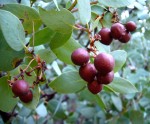Native Gardens in Summer Heat
-by Darlene Ward
This summer we have had a scarcity of moisture, with many hot, dry days. Most of us are active in the early morning and then spend the hottest hours either inside or in the shade. Unfortunately, our plants are rooted in place and must take whatever heat comes their way.
Native Plants in Late Summer
Our local native plants are adapted to long, hot summers. Many cope with excessive heat by slowing their growth and entering summer dormancy. They rest and wait for fall and cooler temperatures to start growing again. The problem with summer dormancy in the native plant garden is that our plants rarely look their best just when we want them to cool our landscape. Very few native plants flower in summer and their existing leaves often look dull.
The native plant gardener has several techniques for coping with poor late-summer appearance.
- Mix Mediterranean plants with our native plants to provide visual interest and color. This method diverts the viewer’s awareness of native plants when they are not at their best.
- Select native plants that provide summer interest or are evergreen. The Theodore Payne Foundation lists possible choices at http://www.theodorepayne.org/mediawiki/index.php?title=Summer_Planting_Tips. Summer interest plants include buckwheat with dried flower heads, desert willow with early summer flowers, apricot mallow with summer blooms, mountain mahogany with seed heads in late summer and warm season grasses. I would add zauschneria, our California fuchsia that blooms in late summer and fall when not much else is blooming. Evergreen plants include manzanita, ceanothus, coffeeberry, coyote brush, mountain mahogany and toyon. My additions to the list are carpenteria, catalina perfume, coast silk-tassel, fremontodendron, huckleberry and mahonia.
- Supply supplemental water. Some summer dormant plants, such as fuchsia-flowered gooseberry, will remain green longer if they receive some water. A general guideline is that native plants will welcome deep irrigation once a month during the hottest months, but this may vary depending on soil type and the plants that are involved. It is important to know which plants can stand water without succumbing to root rot (never water fremontodendron). Young plants must receive water during their first two or three years in the garden even though they are called drought-resistant. Some gardeners never apply supplemental water to their native plants. I suspect their success is related to the conditions and soil within their gardens.
- Let the plants be themselves. There are many plant adaptations for withstanding heat and reducing moisture loss. Some of them are thick waxy leaves, very small leaves, finely-divided leaves, grey leaves, scaly leaves, fuzzy surfaces, resinous coatings, spines and deep taproots. Manzanitas have vertical leaves that they can rotate to control the amount of sunlight. Some plants roll their leaves at the edges or simply drop their leaves to reduce surface area. There are plants that rely on bare stems, not leaves, to photosynthesize. Some plants open their stomata at night when temperatures are cooler. Succulents have thickened stems and leaves to hold moisture. Semi-parasitic plants draw moisture from their host plants. Annuals complete their flowering and seed production cycle by early summer, thus avoiding the problem of heat.
Heat Stress
Symptoms of heat stress are much the same as moisture stress: wilting or folded leaves, dull green foliage, leaf drop and new leaves smaller than normal. Sunburned plants may have discolored silvery or reddish-brown leaves with areas of necrosis, such as brown tips and leaf margins. The bark of trunks and branches can be cracked and peeling, usually on the south or southwest sides.
The logical remedy for heat stress is to reduce the heat exposure of the plant. Observe if wilting occurs during mid-day, with the plant recovering when the temperature drops at night. This may occur even if the plant has adequate moisture. Examine the soil to be sure it is damp below the surface in spite of the surface looking dry. If it is a recent planting, be sure that the rootball isn’t drying out. A shade cloth will provide cooling if symptoms seem extreme. Sometimes the solution is simply putting “the right plant in the right place,” knowing the microclimates of your property and providing sensitive plants shade from other plants or buildings and protection from drying wind exposure. Knowing a plant’s native habitat helps us in planning where to put the plant in our own landscape.
Many of our native plants will “hang in there” in the heat of summer. Thinking about the diversity of adaptations has enriched my viewing of native plants both in the wild and in my own garden. I’ll do what I can to help my garden plants survive, but the fact is they often do what is needed on their own.





